5 recommendations on Big Blind defense vs Small Blind steal
You already know in which situations you can easily steal the big blind when you are in the Small Blind position. Equally important is mastering the skills of effective play in the blind battle while being on the defending side.
In this article, we will discuss five essential factors for successful big blind defense against a Small Blind steal.
Contents:
Evaluate the Small Blind stealing frequency
Look for profitable resteal spots
Analyze your opponent’s flop continuation bet frequency
# Evaluate the Small Blind stealing frequency
Pay close attention to how often your opponent goes for the Small Blind steal.
The more frequently the player to the right open-raises, the greater the number of weak hands included in their range. Consequently, you should defend more hands in the Big Blind, and vice versa.
Let’s compare the steal ranges from the Small Blind of two players:
Player 1:
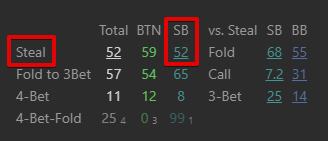
In the pop-up, we see that this player steals 52% of the time from the Small Blind. Undoubtedly, this is quite a wide range, but how wide is it exactly?
In most poker rooms using Hand2Note 4, you can not only check the frequency of the opponent’s steal but also see which specific hands they picked for this action by opening the preflop diagram:
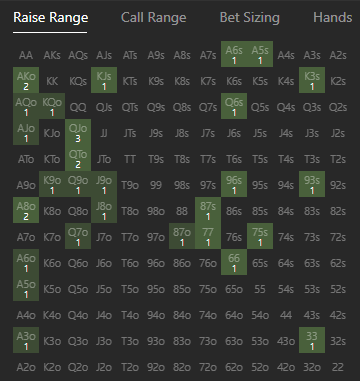
Knowing that the opponent has opened with hands as weak as Q7o and 93s, it's advisable to expand your range in defending the big blind, attempting to outmaneuver such a loose player by leveraging your positional advantage.
Player 2
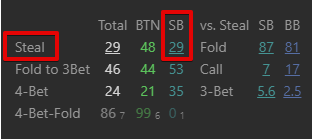
The steal frequency from the Small Blind of the second player is significantly lower, standing at 29%. A lower frequency indicates a narrower and stronger range of hands. Let’s take a look at the preflop diagram:
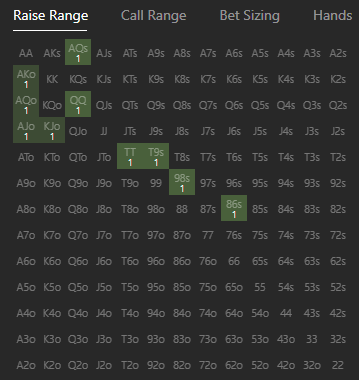
Indeed, this player’s steal range looks quite solid, and against such an opponent, you should be more conservative when choosing hands to defend the big blind.
# Pay attention to the PFR stat
If you have little information about your opponent’s Small Blind steal frequency, you can rely on their PFR stat and understand how aggressively they play preflop. This indicator is calculated and updated after each hand, so you will have a reliable sample size relatively quickly.
Generally, the higher the player’s PFR value, the more actively they will try to steal your big blind. Let’s track this correlation using Multi-player reports in Hand2Note 4. This feature allows you to identify common traits in the playstyle of similar players and build exploitative strategies against them.

For the report, I selected passive players with a PFR stat value not exceeding 10%. Also, to ensure a reliable sample, I set a condition that each of these players in my database should have at least 1000 hands.
Then, using filters, I simulated a situation where they were in the Small Blind position, and all opponents before them folded.
Clicking on the “Next Actions” tab, we can see that the average steal frequency of passive players is 26%. Such a frequency indicates a strong range, so be attentive when choosing hands to defend the big blind against such opponents.
Now let’s pin this report, create a similar one for aggressive players with a PFR parameter of at least 20%, and compare the reports side by side:
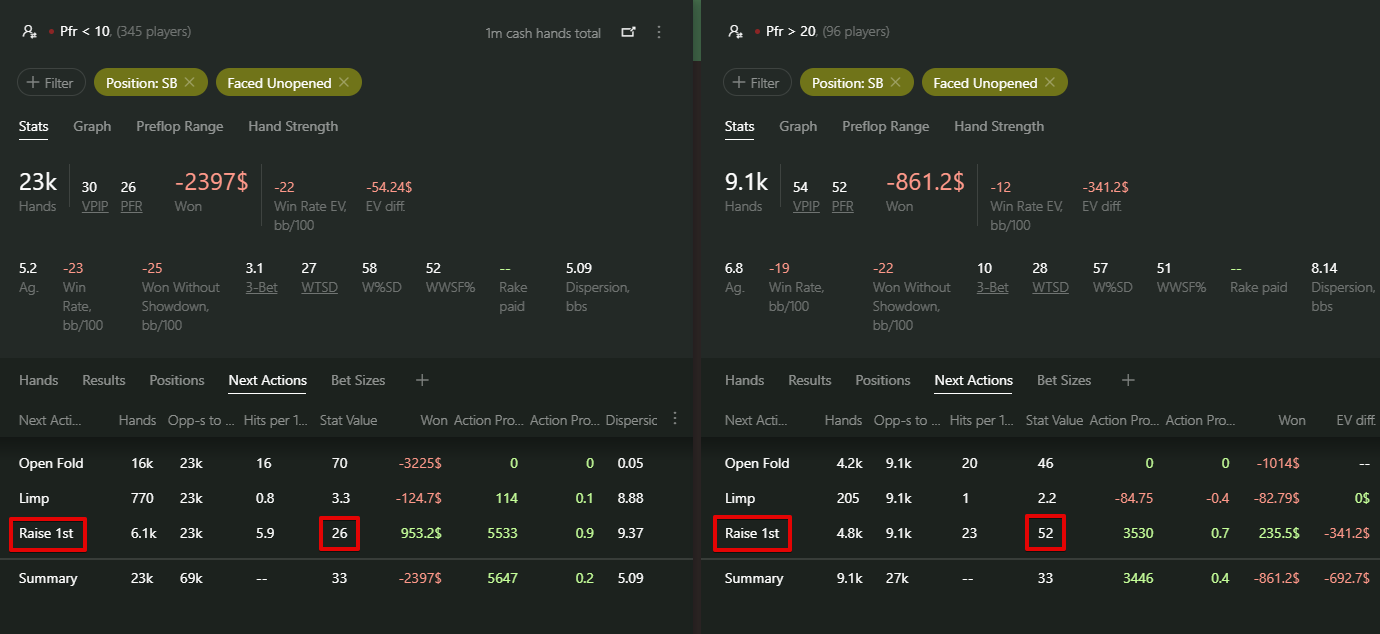
We can observe that aggressive players employ the Small Blind steal tactic twice as frequently, precisely in 52% of cases. In their range, there will already be many weak hands, and against such opponents, you can defend more marginal hands in the Big Blind.
# Look for profitable resteal spots
In Small Blind steal situations, many players exhibit a heightened frequency of folding to a 3-bet since playing a 3-bet pot without a strong hand, without position, and without initiative is an extremely unrewarding scenario in poker that few want to get involved in.
When facing opponents who consistently fold to a 3-bet, it is advisable to expand your 3-bet bluffing range from the Big Blind, utilizing the strategy known as the resteal.
Let’s consider a suitable situation for a resteal:

We were dealt 75 offsuit in the Big Blind and faced a Small Blind steal.
The standard play with our hand in this situation is considered a call, but remember: a successful poker player is not the one who memorized preflop charts the best, but the one who can find leaks in their opponents’ play.
The dynamic HUD of Hand2Note 4 shows that this player steals from the Small Blind 45% of the time, then folding to a 3-bet in 78% of cases.
Guided by these statistics, you must exploit such an opponent with resteals, 3-bet bluffing with any two cards and printing money on their folds.
# Consider the steal size
The steal size often reflects the strength of the hand. Many players, with a strong hand, open with a larger raise, aiming to build a big pot already preflop. With a weak hand, they prefer a small raise, attempting to cheaply steal the big blind.
Let’s once again use the Multi-player reports feature and identify the correlation between the size of the steal and the strength of the range.

I created this report for all players in my database. Using filters, I set a situation where they open-raised from the Small Blind.
Smart reports in Hand2Note 4 are highly convenient because all the necessary information is always at your fingertips. Clicking on the Bet Sizes tab, we can distinguish a linear trend: the smaller the steal size players choose, the more often they fold to a 3-bet, thus indicating a weaker range.
Use this information when defending the big blind and 3-bet more often against small-sized steals.
# Analyze your opponent’s flop continuation bet frequency
Some players try to steal the big blind with a wide range preflop but play straightforwardly on the flop, making a continuation bet only with a good hand and refraining from bluffing.
Be sure to consider the frequency of your opponent’s continuation bet on the flop. The less often the Small Blind player applies pressure, the more hands you can defend on the Big Blind.
When playing in position against a passive opponent, you have full control over the course of the hand and the size of the pot. Even if you get a weak hand on the flop, you will often have the opportunity to take a free card and try to improve on the turn or bluff to take down the pot right away.
In practice, it works as follows:
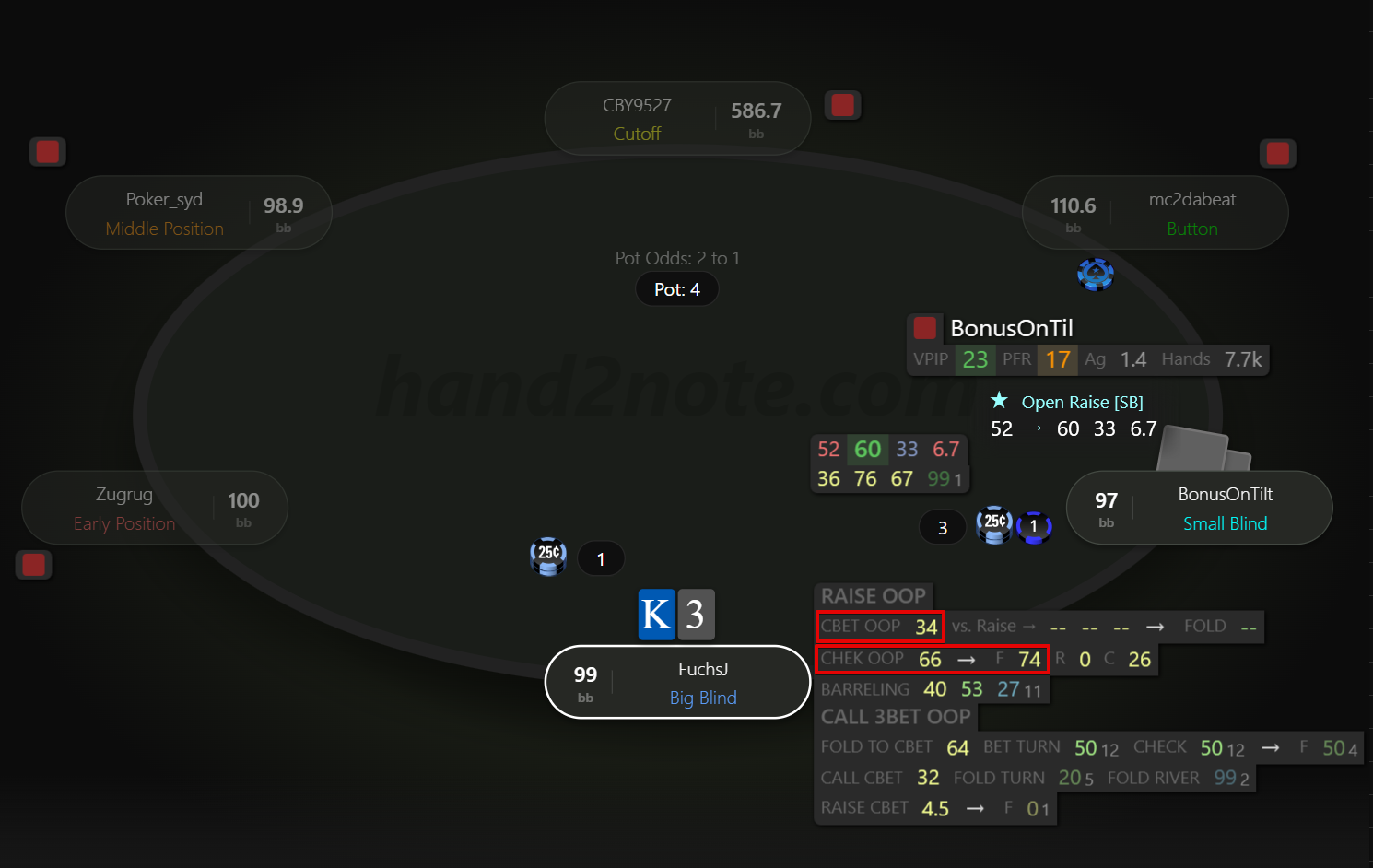
We play in the Big Blind with K3 offsuit, and the player in the Small Blind makes a steal with a 3bb size. Our hand is obviously weak, and the raise size is quite large, but before folding, let’s carefully study the opponent’s tendencies.
In the dynamic HUD of Hand2Note 4, we can find out that being out of position, this player makes a continuation bet on the flop only 34% of the time. But what’s even more intriguing is that after checking on the flop, our opponent folds to a bet in 74% of cases.
Against such a straightforward and passive player, you should defend the big blind with almost any hand, with a plan to take the pot on the flop when they check.
Defending the big blind against a Small Blind steal is an important element of poker strategy, allowing you to minimize losses in that position. For successful defense, you need to understand your opponent’s playing style in the Small Blind and identify weaknesses in their game.
By using Hand2Note 4 and its powerful analytical capabilities, you can quickly interpret your opponents’ statistics, accurately assess their ranges, and completely discourage them from attempting to steal your big blind.
# 5 recommendations on Big Blind defense vs Small Blind steal
You already know in which situations you can easily steal the big blind when you are in the Small Blind position. Equally important is mastering the skills of effective play in the blind battle while being on the defending side.
In this article, we will discuss five essential factors for successful big blind defense against a Small Blind steal.
Contents:
Evaluate the Small Blind stealing frequency
Look for profitable resteal spots
Analyze your opponent’s flop continuation bet frequency
# Evaluate the Small Blind stealing frequency
Pay close attention to how often your opponent goes for the Small Blind steal.
The more frequently the player to the right open-raises, the greater the number of weak hands included in their range. Consequently, you should defend more hands in the Big Blind, and vice versa.
Let’s compare the steal ranges from the Small Blind of two players:
Player 1:

In the pop-up, we see that this player steals 52% of the time from the Small Blind. Undoubtedly, this is quite a wide range, but how wide is it exactly?
In most poker rooms using Hand2Note 4, you can not only check the frequency of the opponent’s steal but also see which specific hands they picked for this action by opening the preflop diagram:

Knowing that the opponent has opened with hands as weak as Q7o and 93s, it's advisable to expand your range in defending the big blind, attempting to outmaneuver such a loose player by leveraging your positional advantage.
Player 2

The steal frequency from the Small Blind of the second player is significantly lower, standing at 29%. A lower frequency indicates a narrower and stronger range of hands. Let’s take a look at the preflop diagram:

Indeed, this player’s steal range looks quite solid, and against such an opponent, you should be more conservative when choosing hands to defend the big blind.
# Pay attention to the PFR stat
If you have little information about your opponent’s Small Blind steal frequency, you can rely on their PFR stat and understand how aggressively they play preflop. This indicator is calculated and updated after each hand, so you will have a reliable sample size relatively quickly.
Generally, the higher the player’s PFR value, the more actively they will try to steal your big blind. Let’s track this correlation using Multi-player reports in Hand2Note 4. This feature allows you to identify common traits in the playstyle of similar players and build exploitative strategies against them.

For the report, I selected passive players with a PFR stat value not exceeding 10%. Also, to ensure a reliable sample, I set a condition that each of these players in my database should have at least 1000 hands.
Then, using filters, I simulated a situation where they were in the Small Blind position, and all opponents before them folded.
Clicking on the “Next Actions” tab, we can see that the average steal frequency of passive players is 26%. Such a frequency indicates a strong range, so be attentive when choosing hands to defend the big blind against such opponents.
Now let’s pin this report, create a similar one for aggressive players with a PFR parameter of at least 20%, and compare the reports side by side:

We can observe that aggressive players employ the Small Blind steal tactic twice as frequently, precisely in 52% of cases. In their range, there will already be many weak hands, and against such opponents, you can defend more marginal hands in the Big Blind.
# Look for profitable resteal spots
In Small Blind steal situations, many players exhibit a heightened frequency of folding to a 3-bet since playing a 3-bet pot without a strong hand, without position, and without initiative is an extremely unrewarding scenario in poker that few want to get involved in.
When facing opponents who consistently fold to a 3-bet, it is advisable to expand your 3-bet bluffing range from the Big Blind, utilizing the strategy known as the resteal.
Let’s consider a suitable situation for a resteal:

We were dealt 75 offsuit in the Big Blind and faced a Small Blind steal.
The standard play with our hand in this situation is considered a call, but remember: a successful poker player is not the one who memorized preflop charts the best, but the one who can find leaks in their opponents’ play.
The dynamic HUD of Hand2Note 4 shows that this player steals from the Small Blind 45% of the time, then folding to a 3-bet in 78% of cases.
Guided by these statistics, you must exploit such an opponent with resteals, 3-bet bluffing with any two cards and printing money on their folds.
# Consider the steal size
The steal size often reflects the strength of the hand. Many players, with a strong hand, open with a larger raise, aiming to build a big pot already preflop. With a weak hand, they prefer a small raise, attempting to cheaply steal the big blind.
Let’s once again use the Multi-player reports feature and identify the correlation between the size of the steal and the strength of the range.

I created this report for all players in my database. Using filters, I set a situation where they open-raised from the Small Blind.
Smart reports in Hand2Note 4 are highly convenient because all the necessary information is always at your fingertips. Clicking on the Bet Sizes tab, we can distinguish a linear trend: the smaller the steal size players choose, the more often they fold to a 3-bet, thus indicating a weaker range.
Use this information when defending the big blind and 3-bet more often against small-sized steals.
# Analyze your opponent’s flop continuation bet frequency
Some players try to steal the big blind with a wide range preflop but play straightforwardly on the flop, making a continuation bet only with a good hand and refraining from bluffing.
Be sure to consider the frequency of your opponent’s continuation bet on the flop. The less often the Small Blind player applies pressure, the more hands you can defend on the Big Blind.
When playing in position against a passive opponent, you have full control over the course of the hand and the size of the pot. Even if you get a weak hand on the flop, you will often have the opportunity to take a free card and try to improve on the turn or bluff to take down the pot right away.
In practice, it works as follows:

We play in the Big Blind with K3 offsuit, and the player in the Small Blind makes a steal with a 3bb size. Our hand is obviously weak, and the raise size is quite large, but before folding, let’s carefully study the opponent’s tendencies.
In the dynamic HUD of Hand2Note 4, we can find out that being out of position, this player makes a continuation bet on the flop only 34% of the time. But what’s even more intriguing is that after checking on the flop, our opponent folds to a bet in 74% of cases.
Against such a straightforward and passive player, you should defend the big blind with almost any hand, with a plan to take the pot on the flop when they check.
Defending the big blind against a Small Blind steal is an important element of poker strategy, allowing you to minimize losses in that position. For successful defense, you need to understand your opponent’s playing style in the Small Blind and identify weaknesses in their game.
By using Hand2Note 4 and its powerful analytical capabilities, you can quickly interpret your opponents’ statistics, accurately assess their ranges, and completely discourage them from attempting to steal your big blind.















